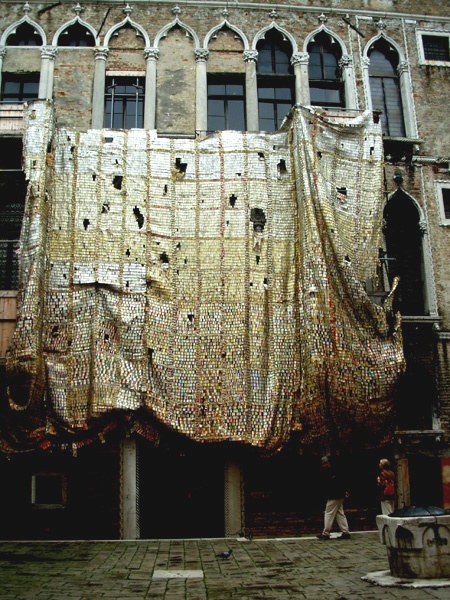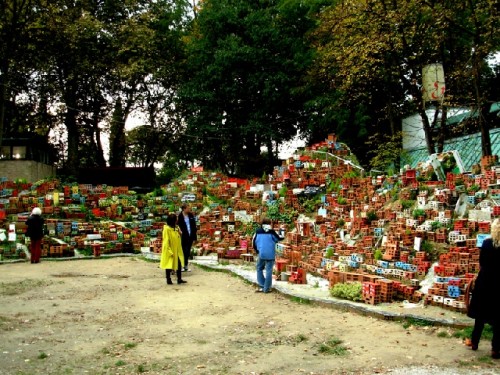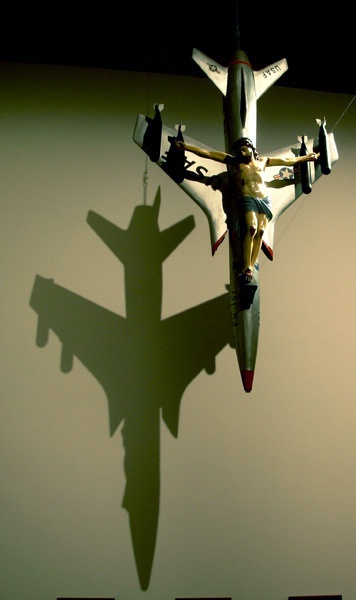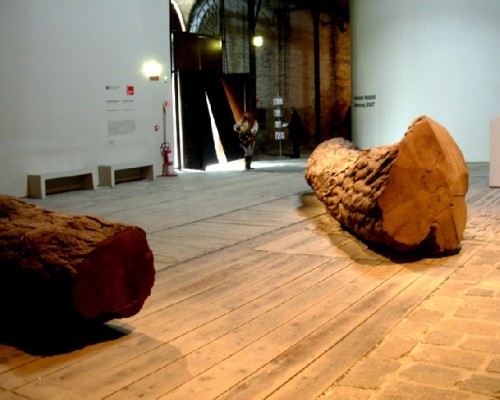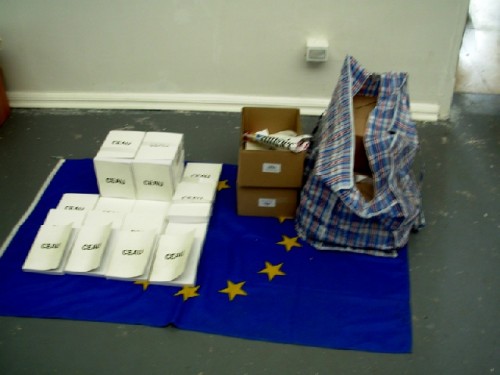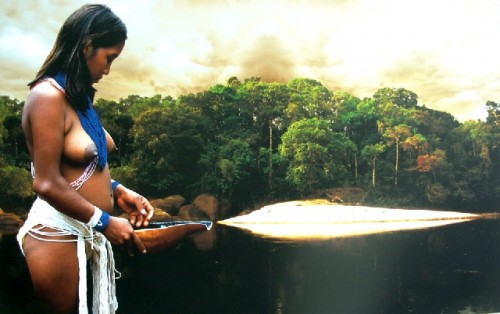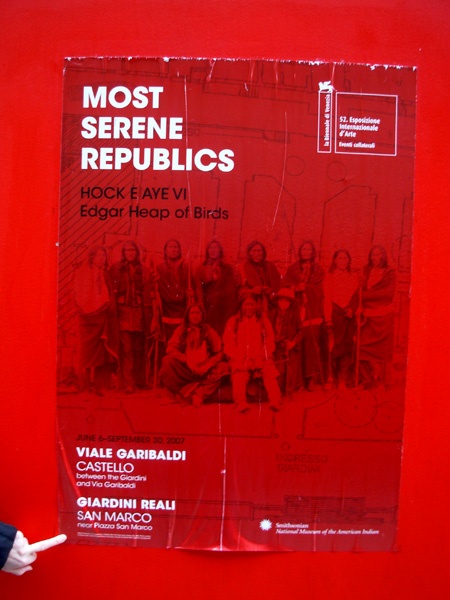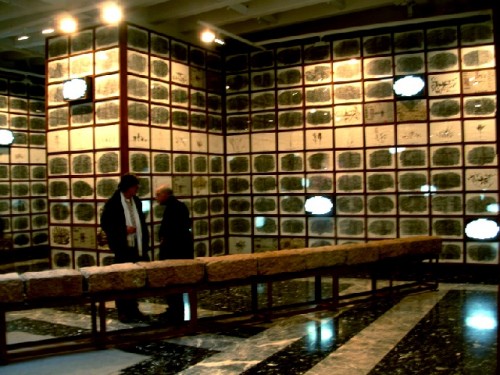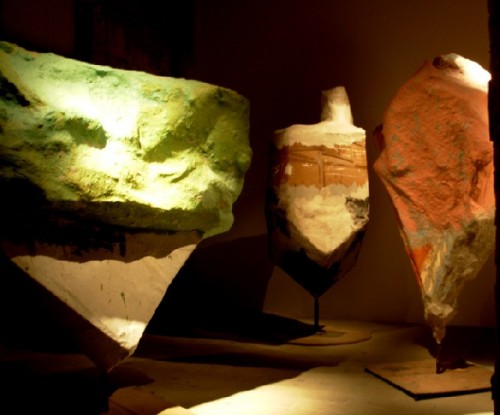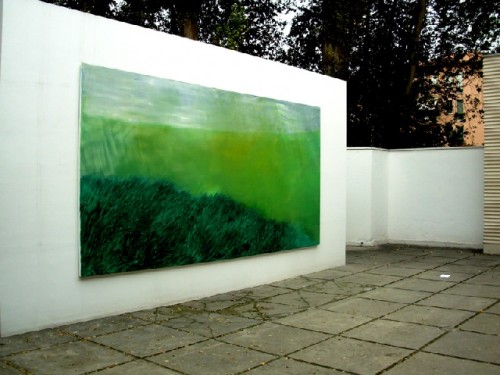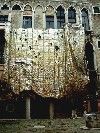Venice Biennale 2007 and Palazzo Fortuny
Highlights and Reflections
By: Charles Giuliano - Dec 02, 2007
Artempo: Where Time Becomes Art
Palazzo Fortuny
http://www.artempo.eu
From my window in Adams there is snow on the ground and a storm expected tonight. We have the shovels placed in the front entrance ready to dig a path to the car. Today, Sunday, I plan to get to the store and purchase supplies should we get snowed in during this our first, full time Berkshire winter.
Yet here I am still thinking and writing about the Venice Biennale and the great intake of art architecture, ancient and contemporary, from our recent three week tour of Northern Italy. Yes, the Biennale is now closed and planning has started for 2009. Surely we will return. So why continue to post thoughts on a now passed event while the rest of the art world moves on to other agendas. Why are we not cavorting in Miami for Art Basel? Or showing up at openings in New York?
Well, because there is still a lot to say and reflect on. The usual approach to the art world entails surfing the latest wave. When possible I like to do that. It is just basic journalism to report on what is fresh and timely. But there is another aspect of this when the cutting edge of art criticism slowly ages and evolves into deeper modes of critical thinking and eventually, art history. From the vantage point of time one sifts through primary sources. Taking the view of history allows for other insights. One notion of history is that it is all a fiction or work in process and that there is no truth to anything. There are the immediate fresh and intuitive responses and then ones that become ever more remote and fogged over.
This past week, for example, there was a news account of the opening of a hitherto off limits Nazi archive with literally miles of file cabinets and boxes full of documents. In a sense it filled me enthusiasm that such material has survived as well as compassion for the individuals who will devote their professional lives to delving into these sources. Will they reveal valued new insights or just prove to be a drudgery for compulsive scholars?
Will future scholars wonder what was thought of the Venice Biennale 2007? Will they research what was universally praised, who won awards, and what important work was overlooked? It is interesting, for example, to read reviews of the 19th Century French salons by Charles Baudelaire. Of course it is significant what he wrote about Manet but he also gave a lot of attention to Salon artists who languished in the basements until the revisionists like Robert Rosenblum wrote about them and the curators of the Musee d'Orsay reinstalled them in the galleries to provide a "complete" overview of the era. And the masses may once again get their fill of William-Adolphe Bouguereau and the other vulgar Salonistas.
There is much to mull over from our travel in Italy and the recent Venice Biennale. It may prove to be a cottage industry until the ice melts in time for the upcoming Whitney Biennial. Those who keep up with the art world must have seven league boots to bounce around the 300 international biennials and the scores of art fairs. Even the most ernest and energetic individuals, with deep pockets or instituional support, keep up with only a fraction of what is going on.
Which is also why the reading habits of the art world are shifting from newspapers and magazines, a culture based on dead trees, to the instant communication of the web. At any given minute somebody is logging on with the latest report on the most remote biennial or art caucus. Even if it is just a group of artists having tea and cakes at the Café Landtmann in Vienna.
One of the compelling and daunting notions is that there are as many Venice Biennales as there are viewers. For 2005 there were reported to be some 250,000 who attended. Counting heads for 2007 will bemore difficult because there were so many national pavilions and related exhibitions scattered all over the city. This development will make visiting Venice all the more significant and daunting in the future.
It was almost by accident that we visited the remarkable exhibition "Artempo: Where Time Become Art" at the Palazzo Fortuny. We were on our way to the Piazza San Marco with Astrid's family from Berlin when I spotted the sign for the Fortuny. It was just an arrow on a wall. I stopped the group and asked if we might take this detour. Then there was the matter of finding it. In Venice never an easy task. There are so many small calles and bridges. After inquiring a few times we found it with a small square in front of the ancient Venetian Palazzo. Draped over the façade of the building was an enormous hanging curtain fabricated from used soda cans by the Ghanian artist El Anatsui. We recognized the work from the Arsenale where it was a hit with visitors and critics. It is the work which was most widely praised and discussed, So we were delighted to experience the work in such a dramatic setting with the natural light of the outdoors compared to the interior space, however grand, of the Arsenale. It was also interesting to note that the work appeared to be worn and damaged from exposure to the elements. But this only enhanced its enchantment and prepared us for the exotic elemements of time, ephemera and decay of the exhibition within.
The exhibition proved to be the highlight of Venice. One of the earliest forms of museums in Europe were the Wunderkammers of Cabinets of Wonders which resulted from the great era of global voyage and discovery. Exotic objects including stuffed animals and human specimens were combined with artifacts of every possible culture. During our tour of the installation, which included masterpieces of contemporary art as well as this ephemra, Bettina asked if I had noticed the tattoed, human skull? The Fortuny project was the combined effort of a team of curators headed by Mattjs Visser, head of exhibitions for the Kunst Palace in Dusseldorf, and the collector and interior designer from Antwerp, Axel Vervvrdt, as well as the former director of the Centre Georges Pompidou, Jean-Hubert Martin. He played an important role in the development of globalism with the legendary 1989 exhibition, Les Magiciens de la Terre. We have provided a link to the site for the Fortuny exhibition which provides a virtual tour as well as additional information.
One of the premises of the Venice Biennale, originating with its founding in 1895 and the establishement of permanent pavilions in the Giardino, was to present the art of the world updated every two years. Of course the definition of what is important has now been entirely revised and expanded beyond the limits of Venice and its historical mandate. But there is a lingering attempt to include all of the continents with the exception of Antartica.
While Africa, the continent, is underrepresented in the Giardino of Venice, there is just a single national pavilion, Egypt, there was an attempt to represent African art in the Arsenale. There was the individual triumph of El Anatsui in the spawling Arsenale. The enormous structure also included "Checklist: Luanda Pop: The African Pavilion" a selection of both African Art and art with African Influences (Andy Warhol, Jean Michel Basquiat) from the collection of Sindika Dokolo a business man from the Congo now based in Luanda. It proved to be a fresh and lively, eclectic mix with a wall of collages by Paulo Kapela, and the post colonial mannequins of Yinka Shonibare which have been widely seen internationally.
While dealing with the density and range of work on view there are wonderful surprises that caused us to linger. The Italian Arte Povere artist, Giseppe Penone (born 1947) provided a stunning installation in the Italian national pavilion. The walls of the space were covered with enormous slabs of crude leather. They formed richly textured patterns of earthy tones. The marble floors were carved to emphasize the natural rhythm of veins which appeared like shallow ripples of water. There were also large trunks of trees laying in their sides which were upholstered in the same leather that is hung on the walls.
Creature comforts proved to be a bit difficult to come by. At the Giardino we spotted three out houses, red, white and blue, but they proved to be a non functional conceptual work by Lars O Ramberg located near a Scandanavia pavilion. Looking around there was no facility so we settled for some bushes behind the pavilions. The snack area was crowded and surrounded by what proved to be a model of a favela created as the "Morrinho Project" by artists from Brazil.
Our responses to the array of pavilions was mixed. While I found the OP installation of Christine Streuli "Go North, Go South, Go East, Go West" in the Swiss pavilon had lots of visual sizzle the after images faded all too quickly. The work was just another manifestation of the revival of interest in the Summer of Love and Psychedelic art with its links to Op designs.
Overall I found the Russian Pavilion pretty awful particularly the large screen video by the AES+F Group "The Last Riot" which just seemed like a bad Matthew Barney production. I needed more time than was possible to make adequate contact with the complex, and poignant but repetitious installation "It There a Future To Our Past? The Dark Face of the Light" by the Japanese artist by Masao Okabe. It is the kind of work one wants to linger over respectfully to reflect on the rubbings of surfaces from Hiroshima. Similarly, we would have profited from more time in the wonderful setting of the selection of work from China. It was installed in an amazingly evocative former industrial site which appeared to have giant boilers associated with the former ship yard. The works involved decorated banners and spears mounted above and a series of video monitors placed between the giant apparatus with images of vibrating Buddhas.
We stumbled onto the work by Christoph Buchel in collaboration with Giovanni Carmine in the Romanian Pavilion. The piece "CEAU (Bootleg)" entailed a pile of books and other objects related to the former regime of Nicolae Ceausescu. There was nothing particularly compelling about the work and my attention derived entirely from the fuss about his battles over an installation at Mass MoCA. Here his efforts were just lost in the shuffle.
In the context of a Biennale the straight photographs of indigenous peoples by Antonia Briceno in the Venezuela Pavilion "Gods of America" were probably just too richly colorful and serenely beautiful. From the commisioner, Zuleiva Vivas, who was on hand, we learned that the artist is also a scientist who has lived with an studied the tribes for extended periods of time. We were delighted to see this presence in Venice. Our friend Jaune Quick to See Smith urged us to check out the work of Edgar Heap of Birds but all we found was a poster stating that the show had closed prior to our visit. During Venice 2005 Jaune and a group of Native artists held a conference sponsored by the National Museum of the American Indian a branch of the Smithsonian. It is unfortunate that there was not a greater presence of indigenous art of the Americas this time.
There are always curiosities to ponder at the Biennale. Why does there appear to be a curatorial consensus for work that I find bloated and ludicrous? Like the absurd sculptures of the Austrian Frans West? And why was the sculpture of Leon Ferrari from 1965 singled out for a prize? What do the curators see that is notable about the bad paintings by Riyas Komu or Y.Z. Kami? Who in their right mind thought of showing the strident kitsch paintings of Eteri Chkadua in the George Pavilion? Why did the videos of Andreas Fogarasi, which were good but not great, in the Hungary Pavilion win top honors that should have gone to Sophie Calle of France?
From the window, the snow is coming down harder. Which will entail another, more pragmatic, form of shoveling.

